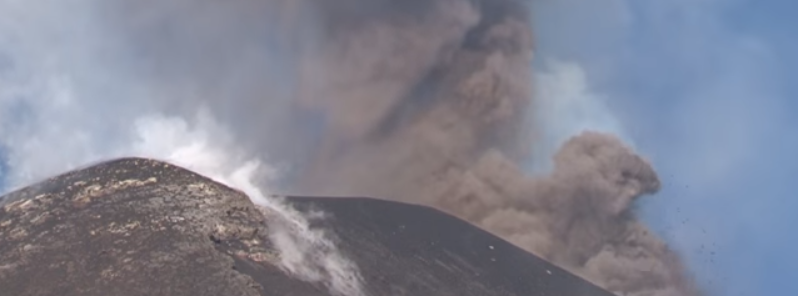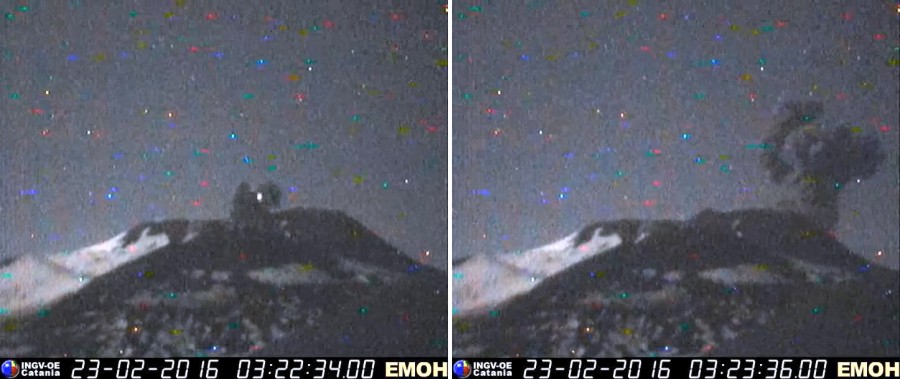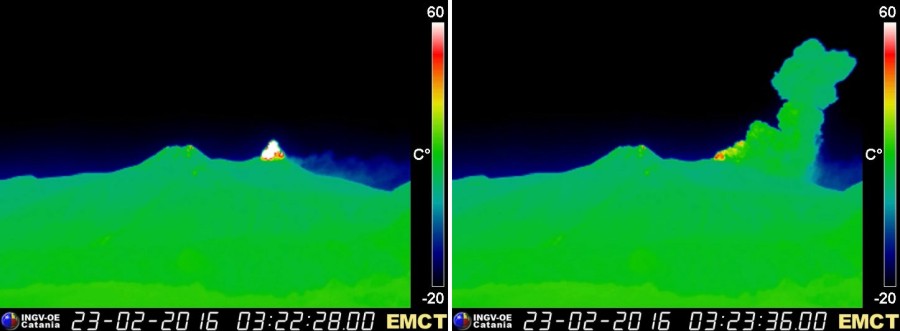Ash plume and incandescent bombs ejected from Etna’s NE crater, Sicily

An unusual eruption was observed from Etna volcano's NE crater on the morning of February 23, 2016. INGV reports several hundred meters high ash plume and incandescent bombs ejected above the rim of the crater.
The video and thermal cameras of the INGV-Osservatorio Etneo (INGV-OE) recorded an explosive event at 03:22 UTC. Incandescent pyroclastics were ejected tens of meters above the crater rim and produced a dark ash plume that spread northeastward, blown by the strong wind. A few lightning flashed were observed in the ash cloud, as well.

Eruption of Etna's NE crater, February 23, 2016. Image credit: INGV Catania

Thermal image of the eruption showing incandescent material ejected from NE crater, February 23, 2016. Image credit: INGV Catania
The images recorded by the thermal surveillance camera at Monte showed an apparent anomaly generated by the explosion, followed by minor ash emission which gradually diminished. As of late morning on February 23, intermittent and weak ash emissions continued from the NE crater.
Etna's eruptive activity has maintained low levels throughout January 2016, according to INGV. A few weak ash emissions have been observed from the November 25, 2015, high vent, located on the eastern flank of the New Southeast Crater (NSEC) cone. A similar phenomenon also occurred during the last week of January and on the morning of February 6. In the same period, degassing from the Northeast Crater (NEC) was occasionally accompanied by minor ash emissions.
On February 19, a field survey was carried out in Etna's summit area by the INGV-OE staff. No ash emissions were reported from the summit craters. However, intense degassing was observed from the open conduits of the NEC. Because of the strong winds, acoustic activity coming from the crater, which typically produces loud bangs and rumblings, could not be heard. Fumarolic degassing at other summit craters was limited to extensive areas along the crater rims. Products of December 2015 eruption that fill the single huge depression constituted by the Voragine and Bocca Nuova were mostly covered in snow, apart from the areas where vapor emitted from fissures formed by compaction of the deposit.

Etna activity, December 6, 2015. Video credit: KdEtna
According to GVP, after intense activity at Etna's Voragine Crater, Bocca Nuova, and the NSEC during the first ten days of December, activity shifted to the NEC. Between December 9 and 10, Strombolian activity was detected at NEC, with a few ejected incandescence bombs falling onto the outer flank and abundant ash emissions. After a couple of days, activity gradually diminished.
On December 13, ash emissions rose from NSEC and on December 18, the Voragine crater produced two brief ash emissions. Ash emissions began on December 28, at 11:00 UTC from a vent located high on the E flank of the NSEC cone. The emissions ceased in the afternoon, and over the next few days, very minor and sporadic explosions continued from the same vent.
Etna volcano was relatively calm since the violent paroxysms of the Voragine summit crater in early December 2015. The volcano erupted violently on December 3 and produced a high lava fountain in several kilometers long eruption column. The paroxysm was one of the most violent Etna's eruptions recorded in the last 20 years. Whether or not, this new activity indicates the beginning of a more significant eruptive phase remains to be seen.
Geological summary
Mount Etna, towering above Catania, Sicily's second largest city, has one of the world's longest documented records of historical volcanism, dating back to 1500 BCE. Historical lava flows of basaltic composition cover much of the surface of this massive volcano, whose edifice is the highest and most voluminous in Italy. The Mongibello stratovolcano, truncated by several small calderas, was constructed during the late Pleistocene and Holocene over an older shield volcano. The most prominent morphological feature of Etna is the Valle del Bove, a 5 x 10 km (16 404 x 32 808 feet) horseshoe-shaped caldera open to the east.
Two styles of eruptive activity typically occur at Etna. Persistent explosive eruptions, sometimes with minor lava emissions, take place from one or more of the three prominent summit craters, the Central Crater, NE Crater, and SE Crater (the latter formed in 1978). Flank vents, typically with higher effusion rates, are less frequently active and originate from fissures that open progressively downward from near the summit (usually accompanied by strombolian eruptions at the upper end). Cinder cones are commonly constructed over the vents of lower-flank lava flows. Lava flows extend to the foot of the volcano on all sides and have reached the sea over a broad area on the SE flank. (GVP)
Featured image: Etna activity, December 6, 2015. Image credit: KdEtna

Commenting rules and guidelines
We value the thoughts and opinions of our readers and welcome healthy discussions on our website. In order to maintain a respectful and positive community, we ask that all commenters follow these rules.